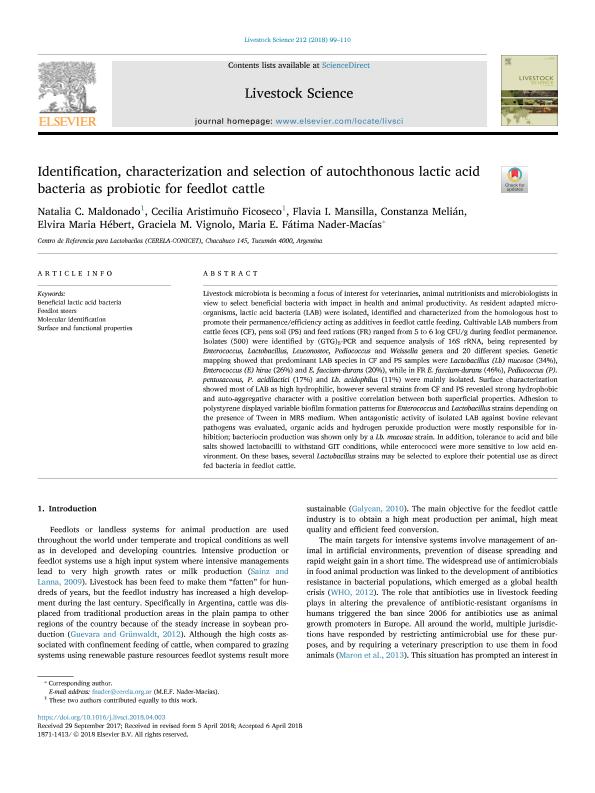Artículo
Identification, characterization and selection of autochthonous lactic acid bacteria as probiotic for feedlot cattle
Maldonado, Natalia Cecilia ; Aristimuño Ficoseco, Maria Cecilia
; Aristimuño Ficoseco, Maria Cecilia ; Mansilla, Flavia Ivana
; Mansilla, Flavia Ivana ; Melian, Constanza Victoria
; Melian, Constanza Victoria ; Hebert, Elvira Maria
; Hebert, Elvira Maria ; Vignolo, Graciela Margarita
; Vignolo, Graciela Margarita ; Nader, Maria Elena Fatima
; Nader, Maria Elena Fatima
 ; Aristimuño Ficoseco, Maria Cecilia
; Aristimuño Ficoseco, Maria Cecilia ; Mansilla, Flavia Ivana
; Mansilla, Flavia Ivana ; Melian, Constanza Victoria
; Melian, Constanza Victoria ; Hebert, Elvira Maria
; Hebert, Elvira Maria ; Vignolo, Graciela Margarita
; Vignolo, Graciela Margarita ; Nader, Maria Elena Fatima
; Nader, Maria Elena Fatima
Fecha de publicación:
06/2018
Editorial:
Elsevier Science
Revista:
Livestock Science
ISSN:
1871-1413
Idioma:
Inglés
Tipo de recurso:
Artículo publicado
Clasificación temática:
Resumen
Livestock microbiota is becoming a focus of interest for veterinaries, animal nutritionists and microbiologists in view to select beneficial bacteria with impact in health and animal productivity. As resident adapted microorganisms, lactic acid bacteria (LAB) were isolated, identified and characterized from the homologous host to promote their permanence/efficiency acting as additives in feedlot cattle feeding. Cultivable LAB numbers from cattle feces (CF), pens soil (PS) and feed rations (FR) ranged from 5 to 6 log CFU/g during feedlot permanence. Isolates (500) were identified by (GTG)5-PCR and sequence analysis of 16S rRNA, being represented by Enterococcus, Lactobacillus, Leuconostoc, Pediococcus and Weissella genera and 20 different species. Genetic mapping showed that predominant LAB species in CF and PS samples were Lactobacillus (Lb) mucosae (34%), Enterococcus (E) hirae (26%) and E. faecium-durans (20%), while in FR E. faecium-durans (46%), Pediococcus (P). pentosaceous, P. acidilactici (17%) and Lb. acidophilus (11%) were mainly isolated. Surface characterization showed most of LAB as high hydrophilic, however several strains from CF and PS revealed strong hydrophobic and auto-aggregative character with a positive correlation between both superficial properties. Adhesion to polystyrene displayed variable biofilm formation patterns for Enterococcus and Lactobacillus strains depending on the presence of Tween in MRS medium. When antagonistic activity of isolated LAB against bovine relevant pathogens was evaluated, organic acids and hydrogen peroxide production were mostly responsible for inhibition; bacteriocin production was shown only by a Lb. mucosae strain. In addition, tolerance to acid and bile salts showed lactobacilli to withstand GIT conditions, while enterococci were more sensitive to low acid environment. On these bases, several Lactobacillus strains may be selected to explore their potential use as direct fed bacteria in feedlot cattle.
Archivos asociados
Licencia
Identificadores
Colecciones
Articulos(CERELA)
Articulos de CENTRO DE REFERENCIA PARA LACTOBACILOS (I)
Articulos de CENTRO DE REFERENCIA PARA LACTOBACILOS (I)
Citación
Maldonado, Natalia Cecilia; Aristimuño Ficoseco, Maria Cecilia; Mansilla, Flavia Ivana; Melian, Constanza Victoria; Hebert, Elvira Maria; et al.; Identification, characterization and selection of autochthonous lactic acid bacteria as probiotic for feedlot cattle; Elsevier Science; Livestock Science; 212; 6-2018; 99-110
Compartir
Altmétricas



